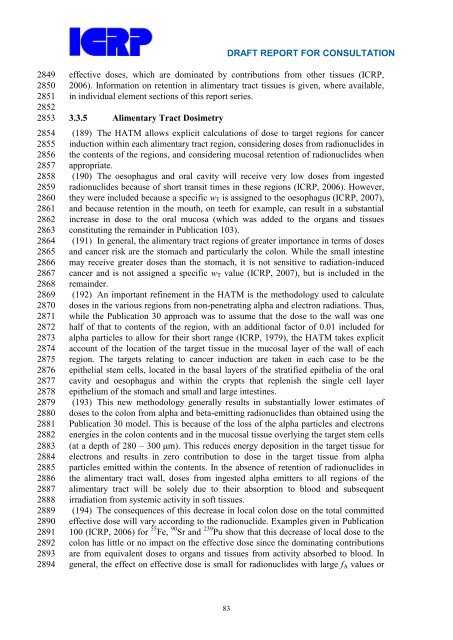Occupational Intakes of Radionuclides Part 1 - ICRP
Occupational Intakes of Radionuclides Part 1 - ICRP
Occupational Intakes of Radionuclides Part 1 - ICRP
Create successful ePaper yourself
Turn your PDF publications into a flip-book with our unique Google optimized e-Paper software.
2849<br />
2850<br />
2851<br />
2852<br />
2853<br />
2854<br />
2855<br />
2856<br />
2857<br />
2858<br />
2859<br />
2860<br />
2861<br />
2862<br />
2863<br />
2864<br />
2865<br />
2866<br />
2867<br />
2868<br />
2869<br />
2870<br />
2871<br />
2872<br />
2873<br />
2874<br />
2875<br />
2876<br />
2877<br />
2878<br />
2879<br />
2880<br />
2881<br />
2882<br />
2883<br />
2884<br />
2885<br />
2886<br />
2887<br />
2888<br />
2889<br />
2890<br />
2891<br />
2892<br />
2893<br />
2894<br />
DRAFT REPORT FOR CONSULTATION<br />
effective doses, which are dominated by contributions from other tissues (<strong>ICRP</strong>,<br />
2006). Information on retention in alimentary tract tissues is given, where available,<br />
in individual element sections <strong>of</strong> this report series.<br />
3.3.5 Alimentary Tract Dosimetry<br />
(189) The HATM allows explicit calculations <strong>of</strong> dose to target regions for cancer<br />
induction within each alimentary tract region, considering doses from radionuclides in<br />
the contents <strong>of</strong> the regions, and considering mucosal retention <strong>of</strong> radionuclides when<br />
appropriate.<br />
(190) The oesophagus and oral cavity will receive very low doses from ingested<br />
radionuclides because <strong>of</strong> short transit times in these regions (<strong>ICRP</strong>, 2006). However,<br />
they were included because a specific wT is assigned to the oesophagus (<strong>ICRP</strong>, 2007),<br />
and because retention in the mouth, on teeth for example, can result in a substantial<br />
increase in dose to the oral mucosa (which was added to the organs and tissues<br />
constituting the remainder in Publication 103).<br />
(191) In general, the alimentary tract regions <strong>of</strong> greater importance in terms <strong>of</strong> doses<br />
and cancer risk are the stomach and particularly the colon. While the small intestine<br />
may receive greater doses than the stomach, it is not sensitive to radiation-induced<br />
cancer and is not assigned a specific wT value (<strong>ICRP</strong>, 2007), but is included in the<br />
remainder.<br />
(192) An important refinement in the HATM is the methodology used to calculate<br />
doses in the various regions from non-penetrating alpha and electron radiations. Thus,<br />
while the Publication 30 approach was to assume that the dose to the wall was one<br />
half <strong>of</strong> that to contents <strong>of</strong> the region, with an additional factor <strong>of</strong> 0.01 included for<br />
alpha particles to allow for their short range (<strong>ICRP</strong>, 1979), the HATM takes explicit<br />
account <strong>of</strong> the location <strong>of</strong> the target tissue in the mucosal layer <strong>of</strong> the wall <strong>of</strong> each<br />
region. The targets relating to cancer induction are taken in each case to be the<br />
epithelial stem cells, located in the basal layers <strong>of</strong> the stratified epithelia <strong>of</strong> the oral<br />
cavity and oesophagus and within the crypts that replenish the single cell layer<br />
epithelium <strong>of</strong> the stomach and small and large intestines.<br />
(193) This new methodology generally results in substantially lower estimates <strong>of</strong><br />
doses to the colon from alpha and beta-emitting radionuclides than obtained using the<br />
Publication 30 model. This is because <strong>of</strong> the loss <strong>of</strong> the alpha particles and electrons<br />
energies in the colon contents and in the mucosal tissue overlying the target stem cells<br />
(at a depth <strong>of</strong> 280 – 300 m). This reduces energy deposition in the target tissue for<br />
electrons and results in zero contribution to dose in the target tissue from alpha<br />
particles emitted within the contents. In the absence <strong>of</strong> retention <strong>of</strong> radionuclides in<br />
the alimentary tract wall, doses from ingested alpha emitters to all regions <strong>of</strong> the<br />
alimentary tract will be solely due to their absorption to blood and subsequent<br />
irradiation from systemic activity in s<strong>of</strong>t tissues.<br />
(194) The consequences <strong>of</strong> this decrease in local colon dose on the total committed<br />
effective dose will vary according to the radionuclide. Examples given in Publication<br />
100 (<strong>ICRP</strong>, 2006) for 55 Fe, 90 Sr and 239 Pu show that this decrease <strong>of</strong> local dose to the<br />
colon has little or no impact on the effective dose since the dominating contributions<br />
are from equivalent doses to organs and tissues from activity absorbed to blood. In<br />
general, the effect on effective dose is small for radionuclides with large fA values or<br />
83

















